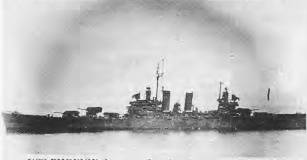- Author
- Head, M.A., S.J.
- Subjects
- Ship histories and stories, Post WWII
- Tags
-
- RAN Ships
- None noted.
- Publication
- March 1990 edition of the Naval Historical Review (all rights reserved)
Most of us have books on our shelves listing losses in various navies during the 1939-45 war. Sometimes we tend to forget that since that war, roughly, countries and groups have taken up arms 140 times. Relatively few of these wars have involved naval actions with large combatants, but a surprising number of ships have been lost. Examine the list below.
Cruisers

Ex-Chungking ex-Aurora (Chinese)
Defected from Nationalists to Communist Chinese forces and sunk in Taku Harbour 2/3/49. General Belgrano (Argentine)
Torpedoed by British Submarine Conqueror, 2/5/82.
Submarines Ghazi (Pakistan)
Sunk by Indian Naval Forces? Mined? 4/10/71? Sante Fe (Argentine)
Damaged and Captured by British forces 25/4/82.
Destroyers, Frigates and Sloops El Amir Farouk (Egyptian)
An old sloop-royal yacht 17 knots, 1,440 tons built in 1926. Sunk by Israeli Naval forces using ex-Italian explosive boats. 21/10/48. Nan Chang ex Chang Chi, ex. Jap. Uji (PLA Navy)
Sunk by nationalist aircraft in the Yangtse 24/9/49. Tai Ping (Taiwan)
Sunk by PLA MTBs 14/11/54. Abikir (Egyptian)
Scuttled at Port Said 1/11/56. Damietta (Egyptian)
Sunk by gunfire H.M.S. Newfoundland 31/10/56. Ibrahim-el-Awal (Egyptian)
Captured following action against sea and air forces. Efforts to scuttle the ship failed when sea cocks could not be found. Alphonso de Alberquerque (Portugese)
Sunk by gunfire. INS Mysore and destroyers 12/61. Elath (Israeli)
Sunk by Egyptian Styx SSM 21/10/67. El Qaher (Egyptian)
Sunk Israeli aircraft at Ras Banas 16/5/70. Khaibar (Pakistan)
Sunk by Indian Styx S SMs 4/10/71. Khukri (Indian)
Torpedoed by Pakistani Submarine Hangor 9/10/71. Kocatepe (Turkish)
Sunk by their own aircraft during Cyprus invasion 22/7/74. Sheffield (British)
Foundered followed damage from Exocet ASM 10/5/82. Ardent (British)
Sunk after multiple bomb and rocket hits from Argentine Aircraft. Antelope (British)
Sunk by detonation of an unexploded bomb 24/5/82. Coventry (British)
Sunk by Argentine aircraft bombs 25/5/82. Milanian (Iranian)
Loss admitted 1982, cause as yet unknown. Kahnamuie (Iranian)
Loss admitted 1982, cause as yet unknown. Reports of a third unit of this PF class being sunk are widely believed. Tariq Ibn Ziyad (Libyan)
Sunk US naval and air forces 24/3/84. Sahand (Iranian)
Sunk by 3 Harpoon ASM and Laser guide bomb US Forces 19/4/87. The above list maybe incomplete or incorrect in places, and I would welcome any criticism. It makes no attempt to list the large number of FAC, patrol vessels, mine warfare vessels, landing craft or auxiliaries that have been lost in the numerous conflicts.
Some Observations
Firstly, ships have been sunk by almost every type of weapon in the naval inventory, from conventional iron bombs and shells, to the most sophisticated guided weapons. The notable absence from the list is the mine. However, mines have crippled ships in post war years, beginning with the celebrated Albanian mining of British destroyers in 1946, to more recent incidents in the Persian Gulf.
Secondly, it does seem that larger units have a better chance of survival than the smaller ones, although ARDENT received enough hits to sink a far larger ship. Generally ships with air cover, and/or medium range SAMs and CIWS have a better chance of survival than the small units without these systems. In addition larger units usually have a more advanced electronic warfare suit.
Thirdly, efficient damage control seems a necessity. USS STARK was saved by the excellence of her crew and systems. It seems likely that SHEFFIELD would have been saved if more attention had been paid to this matter in the initial design.
Warships are built to go in ‘harm’s way’ and as a result we could expect a number to be sunk from time to time. But the lessons from those losses should definitely be learnt so that crews are not needlessly sacrificed. I know that naval officers and maritime experts have gone over the post war conflicts ceaselessly, and come to important conclusions and learnt needed lessons. However, we always have to ask if the lesson is being implemented. A 4.5″ gun mount for destroyers and frigates was a lesson of the Falkland War. The newest batch of the Type 23 design is apparently dispensing with it for economy reasons. SHEFFIELD was sunk in a storm of economy reasons. One wonders how many other ‘lessons learnt’ are being forgotten.




